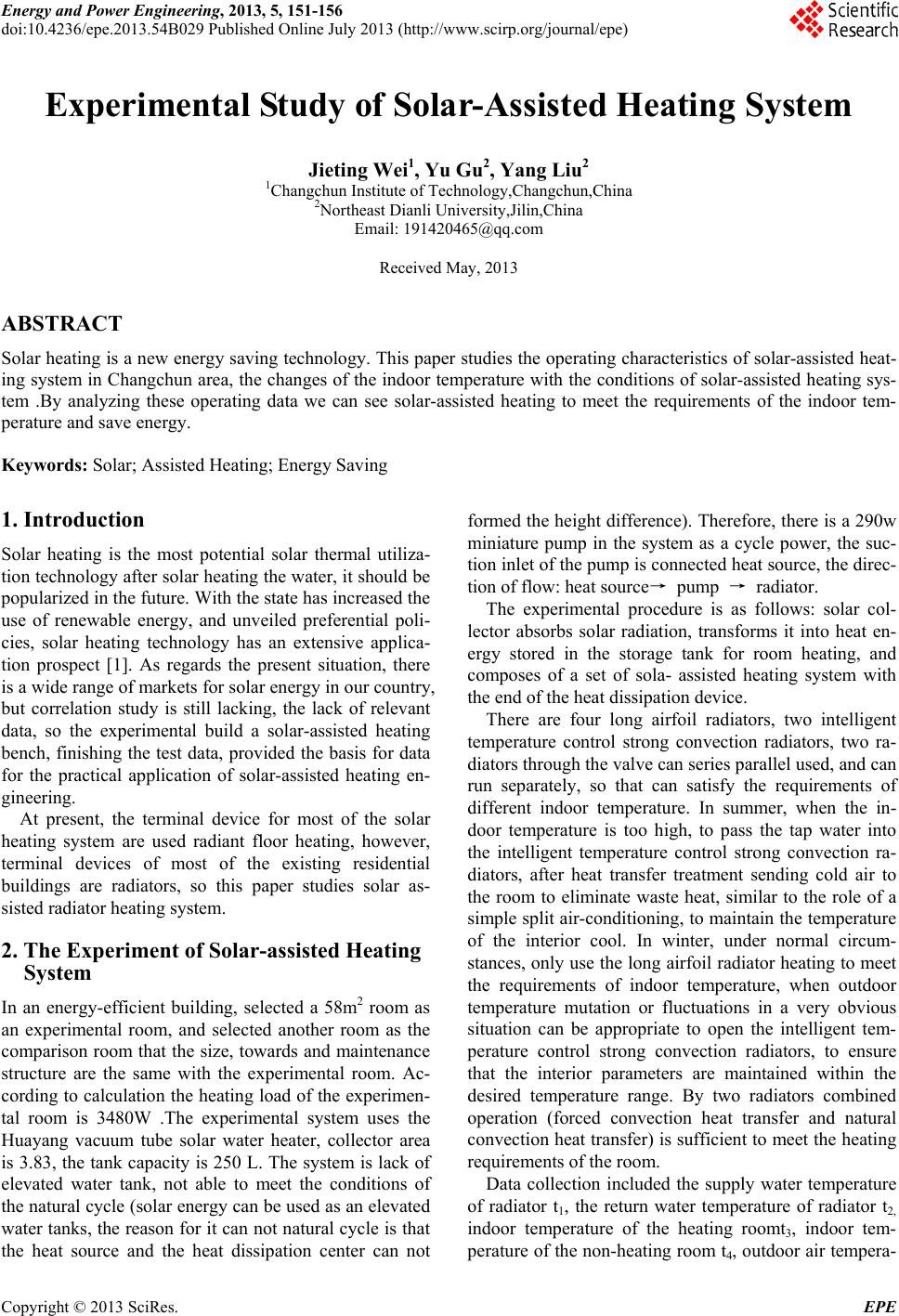
Energy and Power Engineering, 2013, 5, 151-156
doi:10.4236/epe.2013.54B029 Published Online July 2013 (http://www.scirp.org/journal/epe)
Experimental Study of Solar-Assisted Heating System
Jieting Wei1, Yu Gu2, Yang Liu2
1Changchun Institute of Technology,Changchun,China
2Northeast Dianli University,Jilin,China
Email: 191420465@qq.com
Received May, 2013
ABSTRACT
Solar heating is a new energy saving technology. This paper studies the operating characteristics of solar-assisted heat-
ing system in Changchun area, the ch anges of the indoor temperature with the conditions of solar-assisted heating sys-
tem .By analyzing these operating data we can see solar-assisted heating to meet the requirements of the indoor tem-
perature and save energy.
Keywords: Solar; Assisted Heating; Energy Saving
1. Introduction
Solar heating is the most potential solar thermal utiliza-
tion technology af ter solar heating the water, it should be
popularized in the future. With the state has increased the
use of renewable energy, and unveiled preferential poli-
cies, solar heating technology has an extensive applica-
tion prospect [1]. As regards the present situation, there
is a wide range of markets for solar energy in our country,
but correlation study is still lacking, the lack of relevant
data, so the experimental build a solar-assisted heating
bench, finishing the test data, provided the basis for data
for the practical application of solar-assisted heating en-
gineering.
At present, the terminal device for most of the solar
heating system are used radiant floor heating, however,
terminal devices of most of the existing residential
buildings are radiators, so this paper studies solar as-
sisted radiator heating system.
2. The Experiment of Solar-assisted Heating
System
In an energy-efficient building, selected a 58m2 room as
an experimental room, and selected another room as the
comparison room that the size, towards and maintenance
structure are the same with the experimental room. Ac-
cording to calculation th e heating load of the experimen-
tal room is 3480W .The experimental system uses the
Huayang vacuum tube solar water heater, collector area
is 3.83, the tank capacity is 250 L. The system is lack of
elevated water tank, not able to meet the conditions of
the natural cycle (solar energy can be used as an elevated
water tanks, the reason for it can not natural cycle is that
the heat source and the heat dissipation center can not
formed the height difference). Therefore, there is a 290w
miniature pump in the system as a cycle power, the suc-
tion inlet of the pump is connected heat source, the direc-
tion of flow: heat source→ pump → radiator.
The experimental procedure is as follows: solar col-
lector absorbs solar radiation, transforms it into heat en-
ergy stored in the storage tank for room heating, and
composes of a set of sola- assisted heating system with
the end of the heat dissipation device.
There are four long airfoil radiators, two intelligent
temperature control strong convection radiators, two ra-
diators through the valve can series parallel used, and can
run separately, so that can satisfy the requirements of
different indoor temperature. In summer, when the in-
door temperature is too high, to pass the tap water into
the intelligent temperature control strong convection ra-
diators, after heat transfer treatment sending cold air to
the room to eliminate waste heat, similar to the role of a
simple split air-conditioning , to maintain the temperature
of the interior cool. In winter, under normal circum-
stances, only use the long airfoil radiator heating to meet
the requirements of indoor temperature, when outdoor
temperature mutation or fluctuations in a very obvious
situation can be appropriate to open the intelligent tem-
perature control strong convection radiators, to ensure
that the interior parameters are maintained within the
desired temperature range. By two radiators combined
operation (forced convection heat transfer and natural
convection heat transfer) is sufficient to meet the heating
requirements of the room.
Data collection included the supply water temperature
of radiator t1, the return water temperature of radiator t2,
indoor temperature of the heating roomt3, indoor tem-
perature of the non-heating room t4, outdoor air tempera-
Copyright © 2013 SciRes. EPE